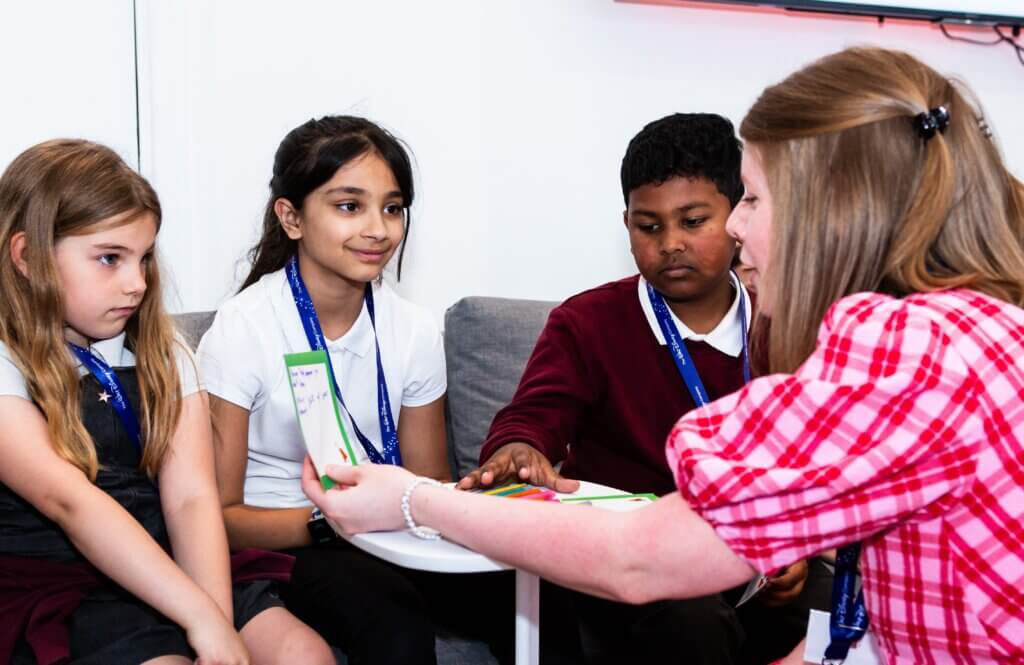
The Childnet Education Team work directly with over 20,000 children and young people every year, visiting around eight schools a week. They also deliver training sessions for teachers and professionals, and have spoken to trainee teachers at universities.
In this blog, we hear from Rosie, a Childnet Education Officer and former primary school teacher about how early career teachers (ECTs) can bring online safety into their teaching practice.
How can it feel trying to tackle online safety as an ECT?
There is a lot to think about when you are an ECT, and often online safety may be something you only had a lecture or two on before you’ve started teaching it yourself. This is why it can feel a little overwhelming to start talking about it with young people, especially if you aren’t feeling confident about your subject knowledge or don’t have much time to devote to finding out more. However, we know online safety is a safeguarding issue, so is important for ECTs and experienced teachers alike.
What’s one thing you wish you knew about teaching online safety when you started teaching?
I wish I’d realised the importance of conversation with young people. Talking is one of the most valuable tools teachers have for helping young people with online safety and can be a simple way to familiarise yourself with what your learners are up to online. It also doesn’t require planning or marking, so can take the pressure off jumping straight in with more formal teaching opportunities.
What should talking about online safety look like?
Whether a discussion is a longer focus on a topic or a quick check in, there are a few things that they should all have in common. You want your learners to feel safe to share so it’s important to make the discussions open and inclusive of all young people’s experiences. Make sure to listen without judgement and not focus on only the negatives of going online. By celebrating the positives of going online too, your learners will feel like you value their online experiences and may feel more confident to share. Crucially, ensure conversations are happening regularly so learners know it is a topic you value and that they can come to you if they have an issue.
How can ECTs promote online safety conversations in the classroom?
There are many ways you can promote online safety conversations:
- Use prompts – If you want to know more about something your learners are engaging with online, you can use a prompt. This could be a picture, a point of view to discuss or a relevant news article. When showing prompts, make sure not to use anything that will lead learners to look up something that is not appropriate for them.
- Ask questions – Questions can be a great tool to finding out more. Some young people will be confident to answer questions about themselves like ‘What did you do online at the weekend?’ or ‘What have you seen online that you enjoyed?’. However, other young people will feel less confident talking about themselves, so asking more broad questions such as ‘What do people your age enjoy doing online?’ or ‘What do you think is an important online safety issue for young people?’ can work well.
- Make time for conversation – Trying to dedicate time each week to talking about the online world, even if it is only for a few minutes. If you talk regularly with a class or form group about what they did over the weekend, a simple step is to add in a question about what they did online. This will give you great insight into your learner’s opinions and experiences.
- Promote online safety across the whole curriculum – Online safety can be discussed at any time, not just in computing or PSHE. You can bring it into other lessons like talking about streaming songs during music or the safety of copying experiments online in science. To see key messages and learning objectives for different ages, the Education for a Connected World framework from the UK Council for Internet Safety provides a good overview.
- Research what you find out – It’s not possible to know everything, so if something comes up during a conversation that you haven’t heard of, do some research to help you understand. Childnet’s regular blogs are a good source of information on varying online issues.
- Use resources – There are plenty of resources that can help you kick start discussions.Childnet’s ‘Youth voice in online safety toolkit’ contains resources that can help start conversations about online safety issues with 3-18 year olds.
What should you do if you find out about an online safety concern?
It’s important to treat an online safety concern the same way you would treat any other safeguarding concern. If a young person discloses something, make sure you listen to them, don’t ask any leading questions and reassure them they have done the right thing by coming to you. The next step would then be to follow to your school or setting’s safeguarding policies and procedures. Childnet’s help and advice for teachers and professionals is a useful tool to help you find out more about particular topics or if you would like to talk to someone, you can contact the Professionals Online Safety Helpline.
What is most important for ECTs to remember about online safety conversations?
- Listen to your learners – Make sure conversation is inclusive of all experiences and not just focusing on the risks.
- Encourage conversation – Make time for discussions and show you value the topic.
- You don’t need to know every aspect of the online world to be able to help – By listening you will already be helping. You can research specific topics after the conversation.
Get support – There are plenty of places you can get help, this could be from your school, online resources or helplines. Childnet’s resource sheet for teachers and professionals signposts


